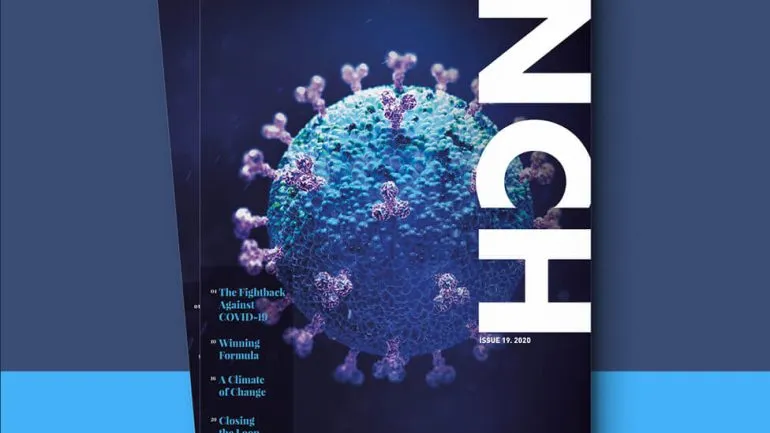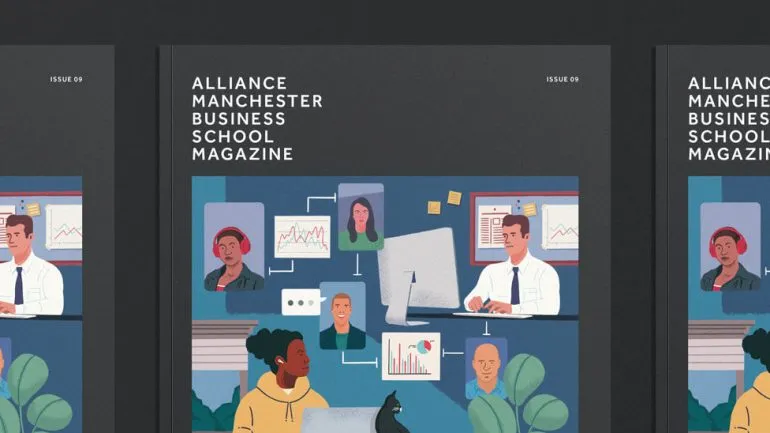Magazine design that connects with audiences – Insights from Peter McMonagle
At Parker Design, magazine design has always been one of the disciplines where creativity and craft come together most powerfully.
To explore what makes great editorial design truly work, we sat down with Peter McMonagle, one of our Art Directors. With years of experience shaping both print and digital publications, Peter brings not only technical expertise but also a genuine passion for how design can transform the reading experience. As part of a magazine design agency that has delivered publications for a wide range of brands, Peter shares insights into the principles, challenges and evolving opportunities that define magazine design today.
Q: What are the key elements of effective magazine design?
A: Effective magazine design is a balance of aesthetics and function. It’s about creating a visual hierarchy that guides the reader’s eye and enhances the content. The key elements include a strong grid system, which provides structure and consistency; typography that is both readable and expressive; and a strategic use of white space to prevent the page from feeling cluttered. A well-designed magazine should feel cohesive, with a distinct visual identity that reflects the brand and its content.
Q: How has digital media influenced magazine design?
A: The rise of digital media has profoundly changed the landscape of magazine design. While print still holds a special place, designers must now think about how their work translates to screens. This means considering interactivity, responsive layouts, and incorporating multimedia elements like video and animations. The challenge is to maintain the core principles of great design – storytelling, hierarchy, and visual appeal – while adapting to the dynamic nature of digital platforms.
Q: What role does typography play in magazine design?
A: Typography is the voice of the magazine. It’s not just about selecting fonts; it’s about creating a typographic system that works across the entire publication. This includes choosing headline, subhead and body fonts that complement each other and a system for sizing and spacing that ensures readability. For example, in our work for INEOS INCH magazine, we carefully selected a combination of fonts that were both modern and highly readable, which was crucial for their complex scientific and business content.
Q: How important is brand consistency in magazine design?
A: Brand consistency is absolutely critical. A magazine is a physical extension of a brand, and every design decision, from the colour palette to the photographic style, should reinforce that brand’s identity. Inconsistency can confuse readers and dilute the brand message. By maintaining a consistent look and feel across all issues and platforms, a magazine can build trust and recognition with its audience.
MAGAZINE GRID SYSTEM
Q: What are the biggest challenges facing magazine designers today?
A: One of the biggest challenges is the need to be platform-agnostic. Designers now have to create for print, web, mobile and social media simultaneously. This requires a deep understanding of each medium’s unique constraints and opportunities. Additionally, with so much content vying for attention, a designer’s role is more crucial than ever in creating designs that are not only beautiful but also compelling enough to cut through the noise and engage the reader.
Q: How do you approach the design of a magazine cover?
A: The cover is the most important element of the magazine. It needs to be a hook that grabs attention immediately. My approach is to treat it as a billboard. The design must be bold, and the hierarchy of information has to be crystal clear. The masthead, main cover line and a striking image should work together to communicate the issue’s essence in a single glance. It’s about blending brand identity with a compelling visual narrative that makes someone want to pick it up.
Q: How do you balance aesthetics with readability?
A: This is a fundamental challenge in all design. The goal is to create something that is not only beautiful but also functional. It’s tempting to use intricate fonts or experimental layouts, but if the reader can’t easily read the text, the design has failed. The key is to prioritise readability without sacrificing visual flair. This means choosing appropriate font sizes, line heights and column widths, and using plenty of white space to give the reader’s eye a rest.
Q: Can a magazine design tell a story on its own?
A: Absolutely. While words tell the literal story, design sets the mood and pace. The design can create a sense of drama, urgency, or calm. For instance, a series of full-page images might slow the reader down, while a dense, multi-column layout could convey a sense of a fast-paced, information-heavy article. By manipulating elements like rhythm, scale and contrast, a designer can create an emotional journey that complements the written content and gives it more impact.
Q: What advice would you give to a designer starting in magazine design?
A: My main advice is to immerse yourself in the craft. Study magazines – both print and digital – and pay attention to what you like and what you don’t. Experiment with grid systems and typography, and remember that every element on the page should have a purpose. Start with the fundamentals of graphic design and then think about how to apply them to a multi-page format. The ultimate goal is to create a seamless and enjoyable experience for the reader, so always keep them in mind.
Q: How do you approach designing for a subject you know little about?
A: This is a fantastic question and a crucial part of the job. I believe that a great designer is also a great student. When I’m faced with a topic I have no knowledge of, my first step is immersion. I’ll do my own research to grasp the core concepts, the key terminology and the overall tone of the subject. This isn’t about becoming an expert, but about understanding the narrative well enough to create a design that visually supports and enhances the text. It allows me to make informed decisions about imagery, typography and layout that resonate with the content’s meaning.
Q: Why is this research step so critical?
A: Without research, a designer is just making educated guesses. The design might look good, but it won’t truly connect with the subject matter. For example, if I’m designing an article about a complex chemical process, like one we did for INEOS INCH magazine, I need to understand the relationship between different elements and how they flow. My research helps me create a visual narrative – perhaps using a more clinical, organised grid or specific infographics – that makes a difficult subject easier for the reader to digest. The design becomes an educational tool, not just an aesthetic one.
Q: Does this research influence your design choices?
A: Absolutely. My research directly informs every design choice. The visual cues, colour palettes, and even the pace of the layout are all influenced by my understanding of the subject. For instance, a feature on sustainable architecture might call for a clean, organic design with a muted colour palette. In contrast, an article about a new space exploration mission might use a dynamic layout with bold, futuristic typography. The research gives me the conceptual framework I need to build a design that feels authentic and appropriate.
ANIMATED DIGITAL MAGAZINE
Q: How does this deep understanding affect the final product?
A: A design born from understanding is a powerful thing. When a designer genuinely grasps the subject, the end product feels more cohesive and deliberate. It builds trust with the reader because they can tell that the visuals aren’t just decorative; they’re an integral part of the storytelling. Ultimately, it elevates the entire magazine from a collection of articles into a unified, thoughtful and high-quality publication.
Q: What’s the biggest lesson you’ve learned from designing for a new topic?
A: The most important lesson is that curiosity is a designer’s greatest asset. Approaching a new topic with a genuine desire to learn not only improves the final design but also makes the process more rewarding. It pushes me to think outside my usual design habits and explore new visual territories. Every new article is a chance to learn something new, and that continuous learning makes me a better designer. It’s a reminder that my job is not just about moving pixels around, but about communicating ideas effectively.
Q: Let’s go back to the start for a moment – what’s the secret to a great table of contents?
A: The table of contents is the magazine’s navigational hub. A great TOC is more than just a list of articles – it’s a visual guide. It should give the reader a quick overview of the magazine’s content and a feel for its tone. I like to use imagery, clear typography and a strong visual hierarchy to make it easy for readers to find what they’re looking for. It also helps to tease key stories, building anticipation for the content ahead.
Q: And last but not least, how do you respond to clients who feel a magazine isn’t right for them – perhaps too costly, or just a ‘nice to have’?
A: I completely understand that perspective – magazines can seem like a luxury, especially when so much content is now digital. But I see a magazine as something with lasting value. It’s not just a printed piece – it’s a physical expression of a brand’s story, personality and credibility. Unlike online content that’s quickly replaced, a magazine stays with people. It’s something they keep, revisit, and share. It creates a sense of connection and pride that’s hard to achieve through other channels. When clients start to view it as part of a wider brand and communication strategy rather than a standalone expense, they usually see its real worth. It becomes an investment in meaningful engagement and connection, not just in print.
Looking ahead
Great magazine design doesn’t just present content, it creates an experience readers want to return to. As a magazine design agency, Parker Design brings together creativity and strategy to deliver publications that strengthen brand identity and build lasting connections. Even if magazine design isn’t something you’ve considered before, it really can be a powerful way to engage your audience and strengthen your brand. Let’s talk – we’d love to help you explore what a magazine could do for your business.
We’re a magazine design agency that gives you way more
If you’d like to discuss a magazine design project or get a quote, we’d love to hear from you.
Magazine design projects

INEOS
Company magazine

AMBS
Business school magazine design

Exodus
Travel magazine design and content
